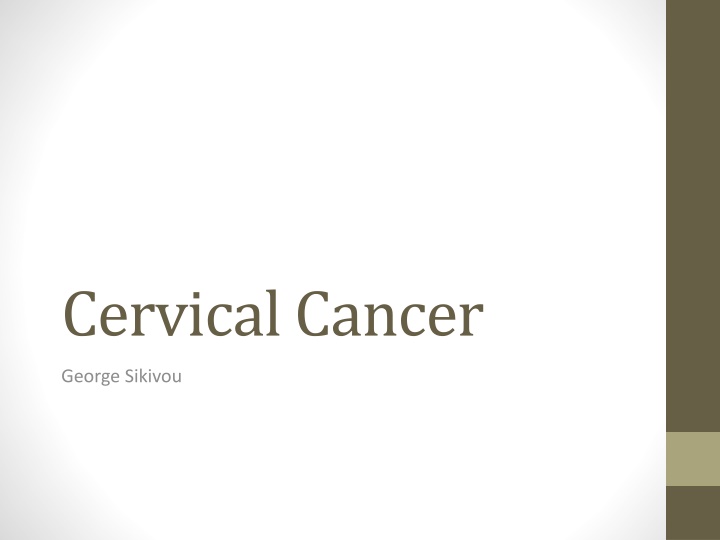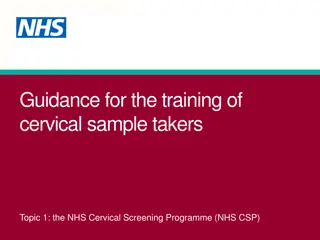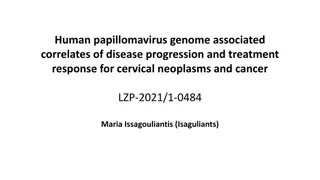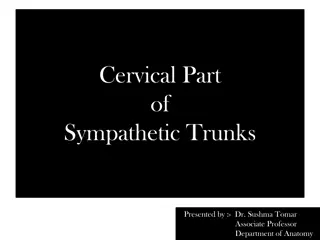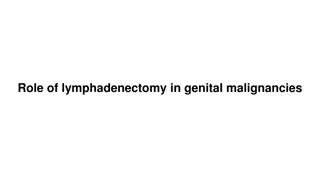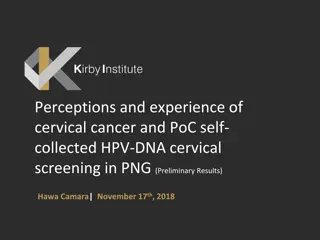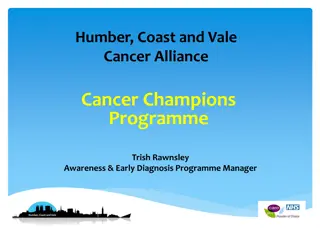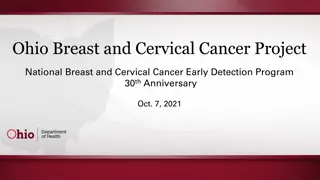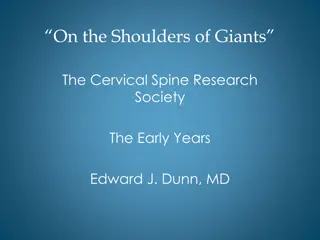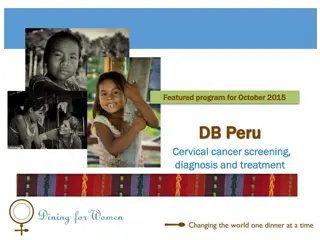Cervical Cancer
Cervical cancer, primarily caused by Human Papilloma Virus (HPV), is a significant health concern worldwide. Squamous Cell Carcinoma (SCC) is the most common type of cervical cancer. In less developed countries, it ranks as the second most common cancer among women. The World Health Organization reported 445,000 new cases and 270,000 deaths in less developed countries in 2012. Proper screening and treatment services are essential human rights, as declared in international conferences like ICPD and Jakarta Declaration. Efforts are being made to empower women and improve investments in health development.
Download Presentation

Please find below an Image/Link to download the presentation.
The content on the website is provided AS IS for your information and personal use only. It may not be sold, licensed, or shared on other websites without obtaining consent from the author.If you encounter any issues during the download, it is possible that the publisher has removed the file from their server.
You are allowed to download the files provided on this website for personal or commercial use, subject to the condition that they are used lawfully. All files are the property of their respective owners.
The content on the website is provided AS IS for your information and personal use only. It may not be sold, licensed, or shared on other websites without obtaining consent from the author.
E N D
Presentation Transcript
Cervical Cancer George Sikivou
What Is It? The cancer of the cervix, which is caused mainly by the Human Papilloma Virus (HPV) 70% of cervical cancers and precancerous cervical lesions are caused by Types 16, 18. Most common type is Squamous Cell Carcinoma (SCC)
It is the second most common type of cancer faced by women in less developed countries 4thcommon type of cancer in women worldwide In 2012, there were 445,000 new cases detected in less developed countries (84%) 270,000 deaths due to Cervical Cancer, 85% were in developing or less developed countries. (WHO Fact Sheet 2014)
MoH Annual Report - 2011
MoH Annual Report 2012
MoH Annual Report 2013
309,334 women are at risk 161 women contract it every year 84 women die from cervical contract (ICO, 2014)
ICPD During the ICPD in Cairo (1994) it was declared that Sexual Reproductive Health is a basic human right. Provision of proper screening and treatment services for cervical cancer is a human right.
Jakarta Declaration States that one of the pre-requisites for health included empowerment of women (Jakarta, 1997) Increase investments for health development reflect needs of women
Yanuca Declaration (1995) People work and age with dignity
Pap Smears Recommended for all women who are sexually active/have had sex Initial pap smear 2nd pap smear: 1 year if normal Consecutive pap smears every 3 years if normal
Use of Thin Prep Test in screening. Sensitivity - 80%, Specificity 63.2% (Chen et al, 2012) Sensitivity 88.3%, Specificity 87.5% (Zhou et al, 2007)
Colposcopy Abnormal pap smears (HGSIL, SCC) are referred for colposcopy Results followed up (6 weeks) 64 abnormal pap smears referred, 34 defaulters
Vaccination There are 2 main types of vaccines available. Cervarix is used in Fiji Protects against Types 16 & 18 Given in 3 doses over 6 months to 13-14 year old girls.
Education During outreach conducted by VSHC, it was shown that: - 40.3% of rural women and girls were not aware of the pap smear test - 68.31% were not aware/had no knowledge on the frequency of the pap smear test. (VSHC, 2014)
47% of CHW had no knowledge of cervical cancer prior to education, with 6% fair knowledge and 22% had good knowledge 52% of the CHW group having no knowledge and 44% had good knowledge of the risk factors (VSHC, 2014)
Teachers showed excellent knowledge of cervical cancer (63.46%) Good knowledge on risk factors (42%) Good knowledge on prevention (48.15%) (VSHC, 2014)
Challenges: The 3 delays: - Delay to seek care - Delay to reach proper medical services - Delay in accessing quality health care (lwhp.sogc.org, 2015)
Barriers Lack of education/awareness Low education level Lack of access to medical services Fear of test/results Shy No symptoms Not at risk (Allen, 2010)
What Can We Do? Build healthy public policy Create a supportive environment Strengthen community action Develop personal skills Reorient health services (Ottawa Charter, 1986)
Sundsvaal Statement (1991) Dimensions : Social taboos Political guarantee commitment to human rights Economic redirecting resources to health/SRH Skills of Women advocacy and participation in health promotion Strategies: Strengthen advocacy women s groups Enable communities/Individuals education
References: Allen, K. (2010). Barriers and Facilitators to Cervical Cancer Screening in Developing Countries, pp. 19-21 Chen, H., Shu, H., Chang, Z., Wang, Z., Yao, H., Zhu, H., Lu, T., Ma, Q. and Yang, B. (2012). Asian Pacific Journal of Cancer Prevention, 13(4), pp.1651-1655. ICO Information Centeron HPV and Cancer, HPV and related cancers, Fact Sheet 2014. Iwhp.sogc.org, (2015). The Three Delays - International Women's Health Program. [online] Available at: http://iwhp.sogc.org/index.php?page=the-three- delays&hl=en_US [Accessed 9 Apr. 2015]. Naidu, S., Rajat, G., et al (2014). Empowerment of Rural Women & Girls in Reproductive Health A VSHC Human Rights Project, pp. 33-58
Ottawa Charter, 1986. Roberts, J., Gurley, A., Thurloe, J., Bowditch, R. and Laverty, C. (1998). Evaluation of the ThinPrep Pap Test as an Adjunct to the Conventional Pap Smear. Obstetrical & Gynecological Survey, 53(5), pp.280-281. Sundsvaal Declaration, 1991. Wu, T. (2008). Cervarix™: a vaccine for the prevention of HPV 16, 18-associated cervical cancer. BTT, p.107. Zhou, J., Tomashefski Jr., J. and Khiyami, A. (2007). Diagnostic Value of the Thin-Layer, Liquid-Based Pap Test in Endometrial Cancer. Acta Cytologica, 51(5), pp.735-741.
